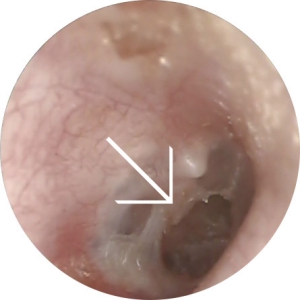Tympanoplasty

Tympanoplasty is an operation to repair holes in the eardrum. It is also known as a Myringoplasty. More information can be found about eardrum perforations here.
The operation
The eardrum (tympanic membrane) is a delicate structure approximately 1 cm across and 0.15 mm thick. Perforations can occur in any part of the tympanic membrane and range from quite small to almost total loss of the drum.
The most common technique to repair the drum is called an underlay graft. The approach may be endoscopic or via small incision just in front of the ear or in more complicated cases via a larger incision behind the ear.
A portion of the skin of the ear canal and the tympanic membrane itself are then delicately elevated to allow access to the back of the tympanic membrane. The graft itself is most commonly fascia, a fibrous layer covering muscles that is harvested from beneath the skin incision.
Once the graft is in place the ear canal is packed with surgical foam soaked in antiseptic to hold the graft in place. If the operation was performed endoscopically no sutures or bandages are needed, otherwise the skin incision is sutured and an antibiotic soaked wick is placed in the ear canal. A dressing is then put over the ear, held in place by a crepe bandage.
After surgery
The first night
Ear surgery is normally very well tolerated, pain and nausea at usually minimal but medications are available to assist if required. The bandage is quite firm and can occasionally cause a mild headache.
Discharge from hospital
The morning following surgery the bandage will be removed and replaced with the smaller cotton wool dressing. Providing a normal diet is being tolerated discharge home will occur mid-morning.
Diet
There are no dietary restrictions
Activity
For the first few weeks I prefer the avoidance of strenuous activity. The duration will depend on the individual operation but will be for at least two weeks
Pain relief
Paracetamol or Nurofen are both fine if required, adults may take stronger analgesia if required.
Postoperative instructions
You will be given instructions for care upon discharge. These are also available to download here. At discharge you will also be given a post-operative appointment and my mobile phone number.